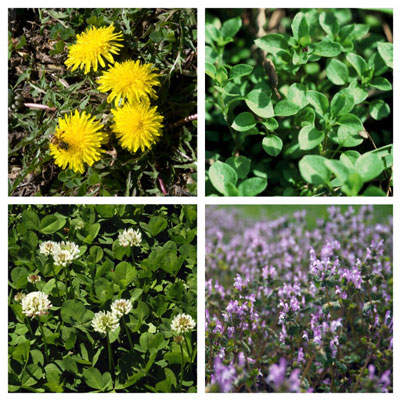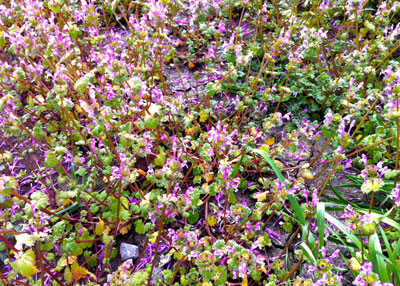Question of the Week: February 15, 2018
“Neil, I have all kinds of weeds out in my lawn. How can I get rid of them?”
The easiest way to answer you is to break the weeds down into two types. Either they are grassy weeds, or they are not.
Grassy weeds include annual bluegrass, rescuegrass and ryegrass.
Non-grassy weeds, better known as “broadleafed” weeds are pretty much all the other weeds that aren’t grasses. It should be noted that “broadleafed” is a horticultural term used to categorize these weeds and differentiate them from true grasses. However, not all broadleafed weeds actually have wide leaves.
Broadleafed weeds growing in your lawn now…
Most common among these are dandelions, chickweed (vigorous green shoots that sprawl across the lawn), henbit (scalloped leaves and small purple flowers in profusion within the next week or two) and white and bur clovers.

Photo: Clockwise from upper left – dandelions, chickweed, henbit and white clover plague Texas lawnkeepers this time of year.
Broadleafed weeds are easily controlled with a category of weedkillers (herbicides) called, appropriately, broadleafed weedkillers. The original one for most of us veteran gardeners was 2,4-D, but then blends containing additional active ingredients started to be sold.
Broadleafed weedkillers are mostly liquids intended to be sprayed onto active new growth. They are taken in through the foliage and sometimes through the soil, and they kill the broadleafed weeds over a period of days to a week or two. Growth becomes deformed and the plants eventually die.
You need to read and follow the directions on the label carefully to be sure you get the best possible results with broadleafed herbicides. Be sure you’re in the appropriate temperature ranges listed. You don’t want rainfall or irrigation within 24 to 48 hours. Don’t mow for a couple of days before or after you apply these products. Repeat as necessary after a few weeks.
You can also apply Gallery pre-emergent granules in the last week of August or the first week of September to keep these weeds’ seeds ever from sprouting.

Photo: When you have this much henbit, your lawn needs a bit of TLC come spring. These weeds will soon run their course.
Grassy weeds you can see out there now…
Annual bluegrass is the most obnoxious among these. It’s the tiny grass that grows to be 4 or 5 inches tall and wide and covers itself in seedheads from now through April or on into May. You can’t eliminate it by mowing. It keeps flowering and forming seeds at ridiculously low mowing heights.

Photo: This is a particularly bad stand of Poa annua annual bluegrass. There is no remedy now. Your only hope will be a pre-emergent application around September 1.
Rescuegrass is a much more rank-growing grass that comes up in big clumps in Texas lawns in the winter. Ryegrass will, too, especially if it has been seeded in past years.
All of these annual grassy weeds can be prevented by application of pre-emergent herbicide granules Team, Dimension or Halts the last week of August or the first week of September.
Once the seeds start to sprout in mid-September it will be too late to apply the pre-emergent and all you’ll be able to do is wait for the next year. We have no spray we can use to kill out these grasses now that won’t also do harm to our permanent lawngrasses.
A couple of special notes…
• I’ll have information on application of pre-emergent weedkillers in next week’s e-gardens. You’re still ahead of that game, so don’t fret yet.
• You’ll see and hear a lot of push for “weed-and-feed” products. Progress is being made in them, but I’m not willing to recommend them right now for one simple reason: It’s way too early to be feeding our lawns. Weed control time is at hand in late February, but lawn-feeding time doesn’t roll in for several more weeks. It’s my opinion that the two tasks should be done separately, each at its own best time.
